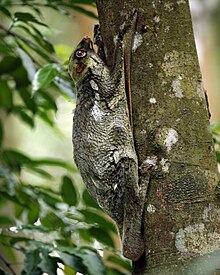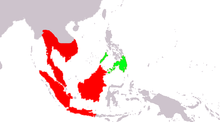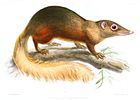| Colugos Temporal range: Eocene-Present, 37–0 Ma PreꞒ Ꞓ O S D C P T J K Pg N | |
|---|---|

| |
| Sunda flying lemur | |
| Scientific classification | |
| Domain: | Eukaryota |
| Kingdom: | Animalia |
| Phylum: | Chordata |
| Class: | Mammalia |
| Superorder: | Euarchontoglires |
| Grandorder: | Euarchonta |
| Mirorder: | Primatomorpha |
| Order: | Dermoptera Illiger, 1811 |
| Family: | Cynocephalidae Simpson, 1945 |
| Type genus | |
| Cynocephalus Boddaert, 1768 | |
| Genera | |

| |
| Synonyms | |
| |
Colugos (/kəˈluːɡoʊ/), flying lemurs, or cobegos (/kəˈbiːɡoʊ/), are arboreal gliding euarchontogliran mammals that are native to Southeast Asia. Their closest evolutionary relatives are primates. There are just two living species of colugos: the Sunda flying lemur (Galeopterus variegatus) and the Philippine flying lemur (Cynocephalus volans). These two species make up the entire family Cynocephalidae (/ˌsaɪnoʊˌsɛfəˈlaɪdi, -ˌkɛ-/) and order Dermoptera (from Ancient Greek δέρμα - dérma, "skin" and πτερόν - pterón, "wing").
Characteristics
Colugos are nocturnal, tree-dwelling mammals.
Appearance and anatomy
They reach lengths of 35 to 40 cm (14 to 16 in) and weigh 1 to 2 kg (2.2 to 4.4 lb). They have long, slender front and rear limbs, a medium-length tail, and a relatively light build. The head is small, with large, front-focused eyes for excellent binocular vision, and small rounded ears.
The incisor teeth of colugos are highly distinctive; they are comb-like in shape with up to 20 tines on each tooth. The incisors are analogous in appearance and function to the incisor suite in strepsirrhines, which is used for grooming. The second upper incisors have two roots, another unique feature among mammals. The dental formula of colugos is: 2.1.2.33.1.2.3

Movement
Colugos are proficient gliders, and thought better adapted for flight than any other gliding mammal. They can travel as far as 70 m (230 ft) from one tree to another without losing much altitude, with a Malayan colugo (Galeopterus variegatus) individual having been observed traveling about 150 m (490 ft) in one glide.
Their ability to glide is possible because of a large membrane of skin that extends between their paired limbs. This gliding membrane, or patagium, runs from the shoulder blades to the fore paws, from the tip of the rear-most fingers to the tip of the toes, and from the hind legs to the tip of the tail. The spaces between the colugo's fingers and toes are webbed. As a result, colugos were once considered to be close relatives of bats. Today, on account of genetic data, they are considered to be more closely related to primates.

Colugos are unskilled climbers; they lack opposable thumbs. They progress up trees in a series of slow hops, gripping onto the bark with their small, sharp claws. They spend most of the day resting. At night, colugos spend most of their time up in the trees foraging, with gliding being used to either find another foraging tree or to find possible mates and protect territory.
Behavior and diet
Colugos are shy, nocturnal, solitary animals found in the tropical forests of Southeast Asia. Consequently, very little is known about their behavior. They are herbivorous and eat leaves, shoots, flowers, sap, and fruit. They have well-developed stomachs and long intestines capable of extracting nutrients from leaves and other fibrous material.
As part of colugos' evolution into a nocturnal species, they developed night vision. Colugos spend their days resting in tree holes and are active at night time; traveling around 1.7 km at night. Colugos may also be a territorial species.
Life cycle
Although they are placentals, colugos raise their young in a manner similar to marsupials. Newborn colugos are underdeveloped and weigh only 35 g (1.2 oz). They spend the first six months of life clinging to their mother's belly. The mother colugo curls her tail and folds her patagium into a warm, secure, quasipouch to protect and transport her young. The young do not reach maturity until they are two to three years old. In captivity, they live up to 15 years, but their lifespan in the wild is unknown.
Status
Both species are threatened by habitat destruction, and the Philippine flying lemur was once classified by the IUCN as vulnerable. In 1996, the IUCN declared the species vulnerable owing to destruction of lowland forests and hunting. It was downlisted to least-concern status in 2008 but still faces the same threats. In addition to the ongoing clearing of its rainforest habitat, it is hunted for its meat and fur. It is also a favorite prey item for the critically endangered Philippine eagle; some studies suggest colugos account for 90% of the eagle's diet.
Taxonomy
Their family name Cynocephalidae comes from the Greek words κύων kyōn "dog" and κεφαλή kephalē "head" because their heads are broad with short snouts like dogs.
Classification and evolution
It is estimated the ancestors of the colugos split from other mammals about 80 million years ago, leading to the present day forms that consist of 7 to 14 extant species. The Mixodectidae and Plagiomenidae appear to be fossil Dermoptera. Although other Paleogene mammals have been interpreted as related to dermopterans, the evidence for this association is uncertain and many of the fossils are no longer interpreted as being gliding mammals. At present, the fossil record of definitive dermopterans is limited to two species of the Eocene and Oligocene cynocephalid genus Dermotherium.
Molecular phylogenetic studies have demonstrated that colugos emerged as a basal Primatomorpha clade – which, in turn, is a basal Euarchontoglires clade. Scandentia are widely considered to be the closest relatives of Primatomorpha, within Euarchonta. Some studies, however, place Scandentia as sister of Glires (lagomorphs and rodents), in an unnamed sister clade of the Primatomorpha.
| Euarchontoglires |
| ||||||||||||||||||||||||||||||
- Order Dermoptera
- †Family Plagiomenidae?
- †Planetetherium
- †Planetetherium mirabile
- †Plagiomene
- †Plagiomene multicuspis
- †Planetetherium
- †Family Mixodectidae?
- †Dracontolestes
- †Dracontolestes aphantus
- †Eudaemonema
- †Mixodectes
- †Dracontolestes
- Family Cynocephalidae
- Cynocephalus
- Philippine flying lemur, Cynocephalus volans
- Galeopterus
- Sunda flying lemur, Galeopterus variegatus
- †Dermotherium
- †Dermotherium major
- †Dermotherium chimaera
- Cynocephalus
- †Family Plagiomenidae?
Gallery
-
 Claw of Sunda flying lemur
Claw of Sunda flying lemur
-
 A red morph of a colugo
A red morph of a colugo
-
 Black morph of a Sunda flying colugo
Black morph of a Sunda flying colugo
References
- ^ Stafford, B.J. (2005). "Order Dermoptera". In Wilson, D.E.; Reeder, D.M (eds.). Mammal Species of the World: A Taxonomic and Geographic Reference (3rd ed.). Johns Hopkins University Press. p. 110. ISBN 978-0-8018-8221-0. OCLC 62265494.
- "Colugo". Lexico UK English Dictionary. Oxford University Press. Archived from the original on February 14, 2021.
- "Colugo". Merriam-Webster.com Dictionary. Merriam-Webster. Retrieved 2016-01-21.
- "Cobego". Merriam-Webster.com Dictionary. Merriam-Webster. Retrieved 2024-11-06.
- Cf. words with analogous pronunciations such as Meningoencephalitis, see "Meningoencephalitis". Lexico UK English Dictionary UK English Dictionary. Oxford University Press. Archived from the original on March 22, 2020.
- ^ Baines, Elizabeth (2001). "Colugos or 'Flying lemurs'". The Natural History Collections. University of Edinburgh. Archived from the original on 30 August 2023. Retrieved 30 August 2023.
- Klein, Jan; Takahata, Naoyuki (2013). Where Do We Come From?: The Molecular Evidence for Human Descent. Springer Berlin Heidelberg. p. 182. ISBN 978-3-66204-847-4. Retrieved 16 December 2024.
- Lim, Norman (2007). Colugo: The flying lemur of South-East Asia. Singapore: Draco Publishing and Distribution Pte Ltd.
- ^ MacKinnon, Kathy (1984). Macdonald, D. (ed.). The Encyclopedia of Mammals. New York: Facts on File. pp. 446–447. ISBN 978-0-87196-871-5.
- Dawkins, Richard (2004). The Ancestor's Tale. Phoenix. ISBN 978-0-7538-1996-8.
- Byrnes, G.; Lim, N.T.; Spence, A.J. (2008). "Take-off and landing kinetics of a free-ranging gliding mammal, the Malayan colugo (Galeopterus variegatus)". Proceedings of the Royal Society B: Biological Sciences. 275 (1638): 1007–13. doi:10.1098/rspb.2007.1684. PMC 2600906. PMID 18252673.
- Janecka, Jan E.; Miller, Webb; Pringle, Thomas H.; Wiens, Frank; Zitzmann, Annette; Helgen, Kristofer M.; Springer, Mark S.; Murphy, William J. (2007). "Molecular and genomic data identify that their closest living relative non-colugo relatives are primates". Science. 318 (5851): 792–794. Bibcode:2007Sci...318..792J. doi:10.1126/science.1147555. PMID 17975064. S2CID 12251814.
- Piotrowski, Jan (2015-05-15). "Zoologger: The clumsy tree-dweller transforms into a gliding ace". New Scientist. Archived from the original on 2021-11-23. Retrieved 2021-11-23.
- Spence, Andrew J.; Yeong, Charlene; Lim, Norman T.-L.; Byrnes, Greg (2011-04-15). "Sex differences in the locomotor ecology of a gliding mammal, the Malayan colugo (Galeopterus variegatus)". Journal of Mammalogy. 92 (2): 444–451. doi:10.1644/10-MAMM-A-048.1. ISSN 0022-2372. S2CID 84539846. Archived from the original on 2018-12-05. Retrieved 2018-12-05.
- Moritz, G. L., Lim, N. T., Neitz, M., Peichl, L., & Dominy, N. J. (2013). Expression and Evolution of Short Wavelength Sensitive Opsins in Colugos: A Nocturnal Lineage That Informs Debate on Primate Origins. Evolutionary biology, 40(4), 542–553. https://doi.org/10.1007/s11692-013-9230-y Archived 2023-11-16 at the Wayback Machine
- "Flying Lemur". A-Z Animals. 25 May 2021. Archived from the original on 24 December 2023.
- Macdonald, David W., ed. (2006). The Encyclopedia of Mammals. Oxford University Press. ISBN 978-0-19-920608-7.
- Amsel, Sheri. "Colugo". Exploring Nature Educational Resource. Archived from the original on 2018-12-23. Retrieved 2018-12-23.
- Chandler, David; Couzens, Dominic (2008). 100 Birds to See Before You Die. London: Carleton Books. p. 171. ISBN 978-1-84442-019-3.
- DNA analysis suggests colugos are part of a primate sister group
- The first dentally associated skeleton of Plagiomenidae (Mammalia, ?Dermoptera) from the late Paleocene of Wyoming. Society of Vertebrate Paleontology 71st Annual Meeting. Las Vegas, NV. November 2011. doi:10.13140/2.1.1302.4322.
- Marivaux, L.; L. Bocat; Y. Chaimanee; J.-J. Jaeger; B. Marandat; P. Srisuk; P. Tafforeau; C. Yamee & J.-L. Welcomme (2006). "Cynocephalid dermopterans from the Palaeogene of South Asia (Thailand, Myanmar and Pakistan): Systematic, evolutionary and palaeobiogeographic implications". Zoologica Scripta. 35 (4): 395–420. doi:10.1111/j.1463-6409.2006.00235.x. S2CID 86572864.
- Meredith, Robert W.; Janečka, Jan E.; Gatesy, John; Ryder, Oliver A.; Fisher, Colleen A.; Teeling, Emma C.; Goodbla, Alisha; Eizirik, Eduardo; Simão, Taiz L. L. (2011-10-28). "Impacts of the cretaceous terrestrial revolution and KPg extinction on mammal diversification". Science. 334 (6055): 521–524. Bibcode:2011Sci...334..521M. doi:10.1126/science.1211028. ISSN 0036-8075. PMID 21940861. S2CID 38120449.
- Zhou, Xuming; Sun, Fengming; Xu, Shixia; Yang, Guang; Li, Ming (2015-03-01). "The position of tree shrews in the mammalian tree: Comparing multi-gene analyses with phylogenomic results leaves monophyly of Euarchonta doubtful". Integrative Zoology. 10 (2): 186–198. doi:10.1111/1749-4877.12116. ISSN 1749-4877. PMID 25311886.
- Scott, Craig S. (5 November 2010). "Eudaemonema webbi sp. nov. (Mammalia, Mixodectidae) from the late Paleocene of western Canada: the youngest known mixodectid". Canadian Science Publishing. 47 (12): 1451–1462. Bibcode:2010CaJES..47.1451S. doi:10.1139/E10-074.
External links
| Extant mammal orders | |||||||||||||||||||||
|---|---|---|---|---|---|---|---|---|---|---|---|---|---|---|---|---|---|---|---|---|---|
| |||||||||||||||||||||
| Yinotheria |
| ||||||||||||||||||||
| Theria |
| ||||||||||||||||||||
| Species of colugos | ||
|---|---|---|
| ||
|  | |
| Euarchontoglires | |||||||||||||||||||||||||||||||||||||||||
|---|---|---|---|---|---|---|---|---|---|---|---|---|---|---|---|---|---|---|---|---|---|---|---|---|---|---|---|---|---|---|---|---|---|---|---|---|---|---|---|---|---|
| |||||||||||||||||||||||||||||||||||||||||
| |||||||||||||||||||||||||||||||||||||||||
| |||||||||||||||||||||||||||||||||||||||||
| Taxon identifiers | |
|---|---|
| Dermoptera | |
| Cynocephalidae | |




